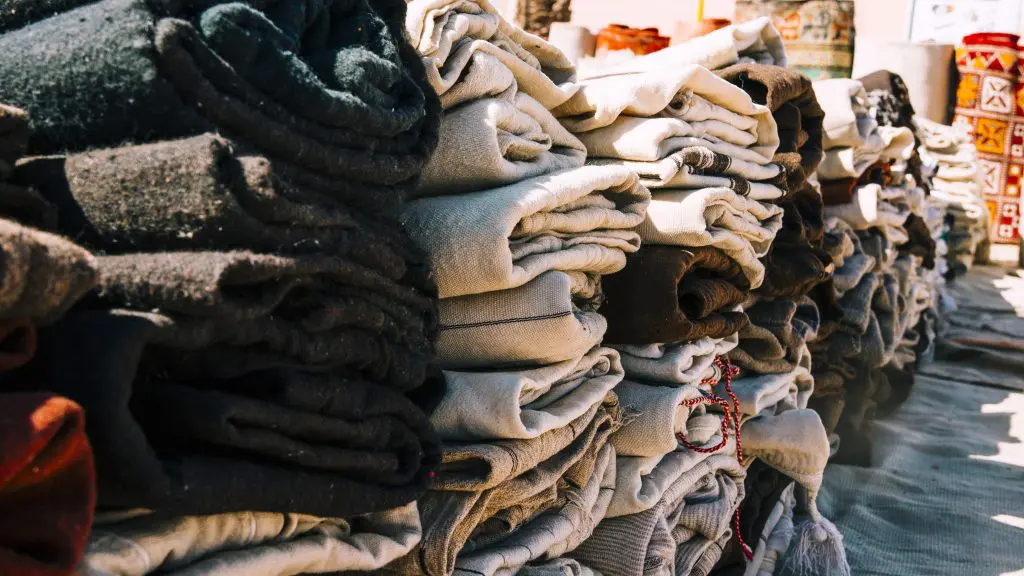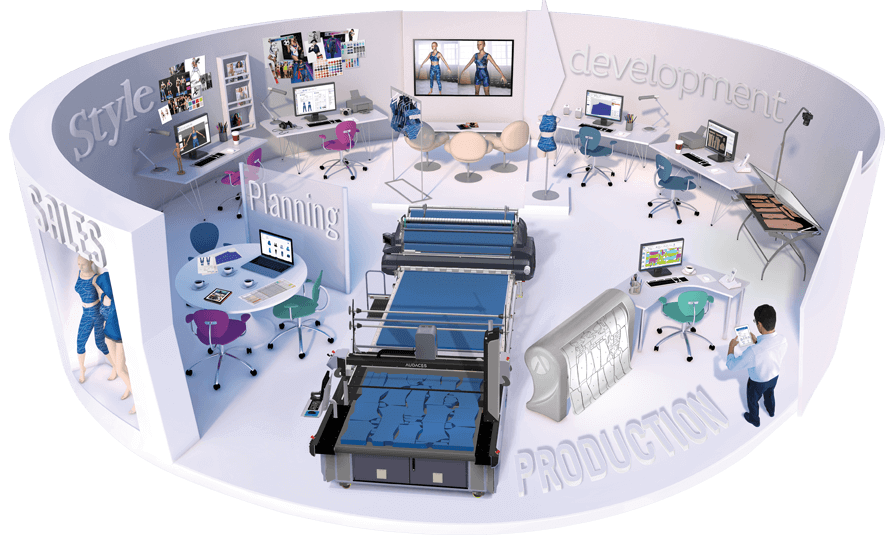Summary
- Textile recycling is a crucial process that repurposes waste materials, promoting sustainability in the fashion industry.
- It involves several key steps to reduce the environmental impact.
- Discover how you can manage every stage of textile recycling with
the Audaces360 multi-solution. Experience a free trial now!
The lifecycle of clothing starts with the creation of raw materials and all too often culminates in improper disposal, contributing to environmental harm.
However, textile recycling offers a solution that aids in preserving natural resources and mitigating the adverse effects of the fashion industry on the environment.
Textile recycling provides a means to transform textile waste into new, valuable products, thus preventing the inappropriate disposal of used clothing and fabrics.
This not only extends the useful life of materials but also minimizes the accumulation of pollutants on our planet.
Sumário
In this article, you’ll explore how textile recycling can be applied to your apparel business and discover its significant benefits.
Get ready to make a positive impact on our environment through responsible manufacturing practices.
Happy reading!
What is textile recycling?
Textile recycling is the transformative process of converting used textile waste into innovative new products or materials.
By doing so, it combats the inappropriate disposal of clothes, fabrics, and other textile items, thereby reducing the environmental impact stemming from the fashion industry and excessive consumption.
The conventional life cycle of a garment begins with the production of raw materials, which can include cotton, wool, polyester, and more.
These raw materials are then skillfully fashioned into fabric, which in turn is crafted into clothing, accessories, or various other textile products.
Unfortunately, these items are often discarded after use, whether due to wear and tear, shifts in fashion, or other factors.
Textile recycling plays a pivotal role in granting these products a fresh lease on life, preventing them from deteriorating into polluting waste occupying valuable space in landfills.
Learn more: How to properly dispose of your clothing company’s textile waste?

How’s the textile recycling process?
The textile recycling process encompasses several steps that contribute to sustainability within the fashion industry by reducing the demand for fresh raw materials and conserving natural resources.
Simultaneously, it curbs the amount of waste deposited in landfills, effectively minimizing the environmental impacts associated with the decomposition of synthetic fabrics.
By endorsing textile recycling and making conscious choices in their consumption habits, people can leave their mark on environmental conservation.
Find out how the textile recycling process works:
Collection

Textile items are gathered from various sources, including recycling stations, second-hand stores, donations, and other channels.
Sorting
The collected materials undergo meticulous classification based on their type, quality, and color, which streamlines the recycling process.
Defibration
In many instances, clothing is shredded to extract its fibers, ensuring the removal of non-recyclable elements such as buttons and zippers.
Fiber recycling
Textile fibers are meticulously processed and transformed into fresh yarns, which can subsequently be employed in crafting new garments and other sustainable products.
Reuse
In some instances, used textile components are simply cleaned and refurbished, making them suitable for resale or donation. This step maximizes the lifespan of textile products, promoting sustainable consumption practices.
Learn more: Why consider sustainable consumption and production for your company?
How to employ textile recycling in your apparel manufacturing
Implementing textile recycling in your clothing manufacturing processes necessitates a genuine commitment to our planet.
By adhering to some guidelines, you will actively contribute to environmental preservation and promote sustainability within the textile industry.
Additionally, these sustainable actions can serve as a potent marketing strategy, demonstrating your brand’s dedication to these critical issues and resonating with conscientious consumers.
Discover how you can seamlessly incorporate textile recycling into your clothing production:
Adopt sustainable raw materials

To implement textile recycling, consider using renewable raw materials in your products. Instead of relying solely on virgin fibers, manufacturers can opt for fibers sourced from recycled clothing or fabrics.
The market offers numerous suppliers in this regard, and this choice significantly reduces the demand for new raw materials, thus conserving our valuable natural resources.
Learn more: Find out what Fashion Revolution is and the purpose of the movement
Reduce dyeing processes
Dyeing is a resource-intensive process that consumes substantial amounts of water and chemicals, making it a major pollutant in the textile industry.
To effectively implement textile recycling, it’s crucial to reduce the necessity for fabric dyeing.
One approach is to work with recycled fabrics that already possess the desired color.
Moreover, employing techniques like natural dyes and more efficient dyeing processes can further diminish the environmental impact.
Reduce waste
Incorporate practices that systematically minimize waste throughout the entire production process to successfully implement textile recycling.
This includes optimizing fabric cutting to maximize material utilization.
Any residual fabric waste can be repurposed or recycled into other products, such as upholstery stuffing or craft materials.
Efficient energy consumption
The textile industry consumes a substantial amount of electrical energy during various manufacturing stages.
To implement textile recycling successfully, clothing manufacturers must commit to reducing their energy consumption.
This can be achieved by using energy-efficient machinery and optimizing production timelines.
Textile waste collection
Establish a textile waste collection system within your clothing factory.
This involves creating designated containers for employees to dispose of clothing and fabrics that do not meet quality standards during the production process.
Proper collection and management of textile waste are crucial components of effective recycling efforts.
Learn more: Learn what ESG score is and how to apply it to your clothing company
Classification and sorting
When collecting textile waste, it’s imperative to meticulously organize it according to material type, color, and quality.
This thoughtful categorization will greatly streamline the subsequent recycling and reuse processes.
Reuse and repair
Prior to considering recycling, thoroughly assess the feasibility of reusing or repairing certain textile components.
This encompasses the transformation of fabrics into new products, not only extending their lifecycle but also infusing your creations with a distinctive, eco-conscious charm.
Partnerships with recycling companies
Forge partnerships with companies or organizations specialized in textile recycling.
These specialized entities possess the expertise to adeptly process textile waste, converting it into valuable new materials or products.
Learn more: How to master sustainable creation and production in the eco fashion era
Inventory management and production control
Waste avoidance is key, and this can be achieved through prudent inventory management and efficient production control.
Meticulously plan the quantity of fabric required and optimize the cutting process to minimize material wastage.
Education and awareness
Inspire your workforce to embrace sustainable and conscientious practices by fostering an environment that underscores the importance of textile recycling and respect for the environment.
Your employees play an fundamental role in ensuring that responsible textile recycling becomes an inherent part of your clothing manufacturing ethos.
Learn more: Explore the opportunities for your fashion business in the textile market
Collaborate with textile recycling using Audaces solutions

Audaces offers advanced technological solutions that can empower your company in its quest for sustainability, with textile recycling as a vital ally in this journey.
Audaces Pattern
The ultimate tool for those seeking to streamline production and enhance efficiency while promoting sustainability: tha’s Audaces Pattern!
Its user-friendly interface serves as a powerful asset in this endeavor.
Additionally, this technology enables the creation of digital patterns up to 70% faster than traditional manual methods!
With this software, you gain access to an automated measurement table, simplifying even the development of intricate patterns, expediting grading, and eliminating the need for paper.
Audaces 3D
Audaces 3D empowers pattern makers to fashion digital prototypes in three-dimensional form, facilitating a lifelike simulation of how garments fit various body types.
Moreover, Audaces 3D grants fashion professionals the freedom to experiment with and visualize fabrics, prints, and colors in 3D, allowing for a meticulous analysis of design possibilities.
An outstanding feature of Audaces 3D is its seamless integration with Audaces Pattern software, streamlining the entire pattern creation process, from initial concept to large-scale production.
The combination of these software tools transforms digital projects into finished patterns, reducing the time and costs associated with collection development.
Audaces Marker
Audaces Marker is a robust tool designed to conserve fabric, enabling maximum utilization and optimizing fittings by up to 13% compared to manual methods.
Thanks to its automated system, Audaces Marker swiftly and efficiently arranges pattern pieces in a matter of minutes.
This automation significantly accelerates the production process, leading to improvements in delivery times.
Moreover, the software offers the added advantage of customization, allowing fittings to be tailored according to the specific requirements of each project.
Audaces Supera
Audaces Supera is an advanced plug-in queue processing solution. This software liberates both the system and operators to undertake other tasks without the need for manual monitoring of the marking process.
This automation results in fabric conservation, time savings in processes, and an overall boost in business productivity.
Thanks to the intelligent control provided by Audaces Supera, digital fittings translate into a remarkable reduction in waste and production costs, potentially saving up to 3%.
Enhanced efficiency leads to greater agility in meeting demands, ultimately bolstering the company’s competitiveness in the market.
Discover how you can eliminate delays in fashion collections and contribute to increased savings and productivity in your fashion business.
Download our free e-book and check some valuable tips:
FAQ
Textile recycling is the process of transforming used textile waste into new products or materials.
Textile recycling includes collection, sorting, defibering, fiber recycling, and reuse.
You can start by reducing dyeing, using recycled fibers, avoiding waste, and cutting electrical energy usage.










